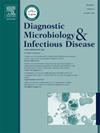化学发光免疫法检测粪便标本中艰难梭菌Cary-Blair培养基的适用性
IF 2.1
4区 医学
Q3 INFECTIOUS DISEASES
Diagnostic microbiology and infectious disease
Pub Date : 2025-06-16
DOI:10.1016/j.diagmicrobio.2025.116959
引用次数: 0
摘要
艰难梭菌感染(CDI)是发达国家院内腹泻的主要原因。用于检测艰难梭菌的化学发光免疫测定(CLIA)需要将粪便标本放在干燥容器中,而胃肠道病原体的分子检测通常使用Cary-Blair运输介质进行。这种差异导致标本拒绝进行CLIA测试。本研究旨在评价Cary-Blair培养基在单次标本采集的情况下,是否适用于CLIA检测谷氨酸脱氢酶(GDH)和毒素A/B。因此,对疑似CDI患者的85份干容器标本(58份毒素A/B阳性,27份毒素A/B阴性),采用DiaSorin's LIAISON®,采用CLIA检测GDH和艰难梭菌毒素A/B。然后将它们转移到Cary-Blair培养基(COPAN FECAL SAWP TM)中,重复分析并与在干容器中获得的结果进行比较。结果表明,在58份干容器标本中,56份cry - blair阳性,所有阴性标本均为cry - blair阴性。此外,该培养基的敏感性为96.55% [95% CI 91.86-100.00],特异性为100%,PPV为100%,NPV为93.10% [95% CI 83.66-100.00]。实验重复24 h保持高度一致。综上所述,Cary-Blair培养基适用于CLIA检测艰难梭菌,节省了材料和分析时间。本文章由计算机程序翻译,如有差异,请以英文原文为准。
Testing suitability of Cary-Blair medium for detection of Clostridioides difficile in stool samples by chemiluminiscence immunoassay
Clostridioides difficile infection (CDI) is the leading cause of nosocomial diarrhea in developed countries. The chemiluminescence immunoassay (CLIA) for detecting C. difficile requires stool specimens in a dry container, while molecular detection of gastrointestinal pathogens is typically performed using the Cary-Blair transport medium. This discrepancy leads to specimen rejection for CLIA testing. The study aimed to evaluate whether Cary-Blair medium is suitable for detecting glutamate dehydrogenase (GDH) and toxin A/B by CLIA, allowing for a single specimen collection. Therefore, GDH and C.difficile toxin A/B were determined by CLIA, using DiaSorin's LIAISON®, in 85 dry container specimens (58 positive and 27 negative for toxin A/B) from patients with suspected CDI. Then they were transferred to Cary-Blair medium (COPAN FECAL SAWP TM) and the analysis were repeated and compared to those obtained in dry container. Regarding the results, of the 58 positive specimens collected in dry container, 56 remained positive in Cary-Blair, while all negative specimens remained negative on Cary-Blair. Moreover, this medium had a sensitivity of 96.55 % [95 %CI 91.86-100.00], a specificity of 100 %, a PPV of 100 % and a NPV of 93.10 % [95 %CI 83.66-100.00]. Additionally, the experiments repeated 24 h remained highly consistent. In conclusion, Cary-Blair medium was suitable for the determination of C.difficile by CLIA, saving material and analysis time.
求助全文
通过发布文献求助,成功后即可免费获取论文全文。
去求助
来源期刊
CiteScore
5.30
自引率
3.40%
发文量
149
审稿时长
56 days
期刊介绍:
Diagnostic Microbiology and Infectious Disease keeps you informed of the latest developments in clinical microbiology and the diagnosis and treatment of infectious diseases. Packed with rigorously peer-reviewed articles and studies in bacteriology, immunology, immunoserology, infectious diseases, mycology, parasitology, and virology, the journal examines new procedures, unusual cases, controversial issues, and important new literature. Diagnostic Microbiology and Infectious Disease distinguished independent editorial board, consisting of experts from many medical specialties, ensures you extensive and authoritative coverage.

 求助内容:
求助内容: 应助结果提醒方式:
应助结果提醒方式:


